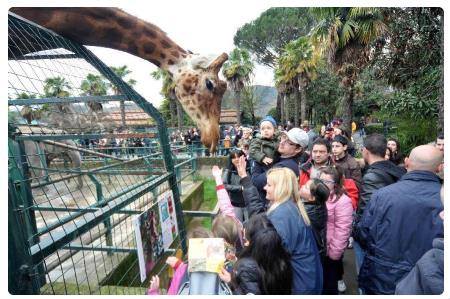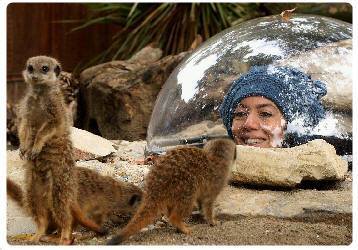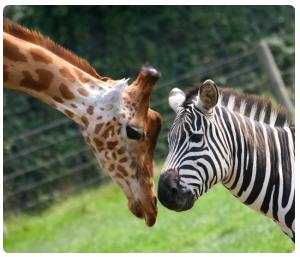|
Sei
qui:
Cosa vedere a Pistoia
>
Pistoia Zoo
|
The zoo
of Pistoia, in Tuscany, is one of the most important zoological
parks in Italy. We have been there a couple of times and it's always a
pleasant surprise to notice its continuous improvement which at the same
time increases the quality of the visit with space for the animals present.
It hosts many known and lesser known species, including tigers, lions,
elephants, giraffes, elephants, hippopotamuses, zebras, camels, penguins,
otaries, lemurs, kangaroos, tortoises, reptiles, bears, wolves.... It is an
ideal place for families, offering an indoor playground and a biodiversity
laboratory for adults and children. Of course, there is also a picnic area,
bar and restaurant. |
|
 Each
animal is described by an interesting card, where in addition to its main
characteristics (how it lives, what it eats, how much it lives, how long the
puppies last, who are its predators), it is shown a map of the places where
it lives and are inserted stimulating curiosities. For example, did you know
that the lion sleeps 20 hours a day? (!). At the weekend there are often
free initiatives to get to know animals and their habits, such as the "bestial
encounters" and the "mobile laboratory" to get to know animals directly,
followed by specialized guides working at the zoo. Each
animal is described by an interesting card, where in addition to its main
characteristics (how it lives, what it eats, how much it lives, how long the
puppies last, who are its predators), it is shown a map of the places where
it lives and are inserted stimulating curiosities. For example, did you know
that the lion sleeps 20 hours a day? (!). At the weekend there are often
free initiatives to get to know animals and their habits, such as the "bestial
encounters" and the "mobile laboratory" to get to know animals directly,
followed by specialized guides working at the zoo.
 Thanks
to the particular attention devoted in recent years to naturalistic and
environmental education activities, the 7 hectares of land and about 500
animals hosted are managed paying attention to the welfare of the animals
and the study of their biology. Many habitats, once cramped, have been
transformed, even though some areas of the old zoo still remain unmodified
where animals are very "narrow". They suffer from the zebra, giraffes and
hippos enclosed in enclosures that are too small for their size, with
concrete flooring, without even a blade of grass. The elephant situation has
improved with a new and open area behind it, which adds to the original one,
with much more space and a sort of "games" that stimulate the beasts. Thanks
to the particular attention devoted in recent years to naturalistic and
environmental education activities, the 7 hectares of land and about 500
animals hosted are managed paying attention to the welfare of the animals
and the study of their biology. Many habitats, once cramped, have been
transformed, even though some areas of the old zoo still remain unmodified
where animals are very "narrow". They suffer from the zebra, giraffes and
hippos enclosed in enclosures that are too small for their size, with
concrete flooring, without even a blade of grass. The elephant situation has
improved with a new and open area behind it, which adds to the original one,
with much more space and a sort of "games" that stimulate the beasts.
Many improvements have been made since the zoo was opened and over time
animal welfare has increased considerably, especially for the already
mentioned elephants, lions, wolves, bears and South African penguins, who
are also able to reproduce here and who have seen a large two arm swimming
pool built entirely new. There are many educational courses for children and
adults (you can participate in the Biodiversity Laboratory inside the
zoo). The zoo at the same time collaborates with other zoos in Europe and
participates in conservation programmes for some animals, such as tigers in
India, penguins in South Africa, lemurs in Madagascar and other species.
 In
this zoo you can meet live animals in an environment that tries to be as
close as possible to the natural environment. It is so that children and
adults can have close encounters with camels, lemurs and flamingos, which
can be admired so close that they feel like touching them (but don't do it,
some may even bite!), and even giraffes, elephants and zebras or from
another part of the park brown bears, tigers and lions or reptiles,
amphibians and insects.... the species are the most common ones. Of course,
you can't feed the animals (other than goats and giraffes from the
dispensers) and you must avoid annoying noises. In
this zoo you can meet live animals in an environment that tries to be as
close as possible to the natural environment. It is so that children and
adults can have close encounters with camels, lemurs and flamingos, which
can be admired so close that they feel like touching them (but don't do it,
some may even bite!), and even giraffes, elephants and zebras or from
another part of the park brown bears, tigers and lions or reptiles,
amphibians and insects.... the species are the most common ones. Of course,
you can't feed the animals (other than goats and giraffes from the
dispensers) and you must avoid annoying noises.
The idea of a zoo in Pistoia came to Raffaello Galardini, a private
with a passion for exotic lands and animals of those places, which was
helped by Angelo Lombardi, who many will know for having been a
well-known television character of the years around 1950; in practice the
first scientific divulgator of Italian television! His show was called "The
Friend of Animals" and was broadcast on the RAI from 1956 to 1964.
 Since
its inauguration in the 1970s, the structure has changed into a crescendo of
exhibition criteria, in an attempt to put animals at ease and interest
visitors. In recent years, for example, new reception areas have been
created for species such as the brown bear, wolves, tigers, lions and lynxes.
The spaces available to the animals have been widened, shielding has been
erected to protect the privacy of the animals (with special strategic
observation points from which to observe them) and projects have been
developed to protect endangered species. To give an example, the brown
bear couple (known as Teddy and Ochila) comes from a zoo
in Romania and are part of the project for the conservation and protection
of the brown bear in Marsica, a subspecies of the brown bear that lives in
some areas of central Italy, such as the Abruzzo National Park and
that is now at risk of extinction; for this reason it is since 1939 that the
species is protected by laws. (Convention on international trade in
endangered species) and the European Habitats Directive. Since
its inauguration in the 1970s, the structure has changed into a crescendo of
exhibition criteria, in an attempt to put animals at ease and interest
visitors. In recent years, for example, new reception areas have been
created for species such as the brown bear, wolves, tigers, lions and lynxes.
The spaces available to the animals have been widened, shielding has been
erected to protect the privacy of the animals (with special strategic
observation points from which to observe them) and projects have been
developed to protect endangered species. To give an example, the brown
bear couple (known as Teddy and Ochila) comes from a zoo
in Romania and are part of the project for the conservation and protection
of the brown bear in Marsica, a subspecies of the brown bear that lives in
some areas of central Italy, such as the Abruzzo National Park and
that is now at risk of extinction; for this reason it is since 1939 that the
species is protected by laws. (Convention on international trade in
endangered species) and the European Habitats Directive.
 The
structure of the zoo of Pistoia is organized in sectors that include
in addition to the areas that host animals, also theme trails,
cafè, restaurant, didactic laboratory, picnic area,
souvenir shop, bathrooms and parking. The entire area
is also Wi Fi area. Animal areas are home to many species, including
vipers, pelicans and cormorants, brown bears, lynxes, reindeer, wolves,
wolves, lions, cows, goats, rabbits, Cameroon sheep, manguste, manguste,
donkeys, camels, African penguins, alpaca, tamarinds, otherness, lemurs,
flamingos, jaguars, porcupines, zebras, zebras, etc. The
structure of the zoo of Pistoia is organized in sectors that include
in addition to the areas that host animals, also theme trails,
cafè, restaurant, didactic laboratory, picnic area,
souvenir shop, bathrooms and parking. The entire area
is also Wi Fi area. Animal areas are home to many species, including
vipers, pelicans and cormorants, brown bears, lynxes, reindeer, wolves,
wolves, lions, cows, goats, rabbits, Cameroon sheep, manguste, manguste,
donkeys, camels, African penguins, alpaca, tamarinds, otherness, lemurs,
flamingos, jaguars, porcupines, zebras, zebras, etc.
 Thematic
routes and itineraries of the zoo of Pistoia are the strong point of the
structure. For schools, for example, the biodiversity laboratory is open (up
to a maximum of 25 children per meeting, with children from 5 to 11 years
old) within the zoo and gives the opportunity to participate in the
construction of a feeder for birds, to know up close ferrets and rabbits,
study the footprints of animals and take them with the plaster cast.... and
what can you say if your child could have a bear for friend? Learning to
protect it, understanding the difference between fairy tales and legends and
the real animal world. Thematic
routes and itineraries of the zoo of Pistoia are the strong point of the
structure. For schools, for example, the biodiversity laboratory is open (up
to a maximum of 25 children per meeting, with children from 5 to 11 years
old) within the zoo and gives the opportunity to participate in the
construction of a feeder for birds, to know up close ferrets and rabbits,
study the footprints of animals and take them with the plaster cast.... and
what can you say if your child could have a bear for friend? Learning to
protect it, understanding the difference between fairy tales and legends and
the real animal world.
What about the animals that we are used to seeing every day, certainly less
exotic than the first described above? In the thematic itinerary
dedicated to the' Vecchia Fattoria' (Old Farm), generally articulated
with meetings in the laboratory and with external activities, there is a
dynamic participation in the life of animals such as cows, sheep, donkeys,
hens, rabbits. We find particularly interesting the program called "They
are not like beliefs: animals between fairy tale and reality", which
leads to a close acquaintance with the animals of fairy tales, whether they
are wolves, foxes or bears (true though and not in plush). For older
children, teaching courses focus on topics such as the importance of
recycling and composting, i. e. the biodegradability of substances
and also on the evolutionary adaptation of our planet and animals.
The zoological garden of Pistoia therefore goes beyond the classic concept
of zoo as a place that hosts animals of different species, proposing
activities able to raise awareness among children and adults about the
protection of our planet and its delicate balance.
Useful information Zoo of Pistoia
Address:
Via delle Pieve a Celle, 160 - 51030 Pistoia, Via delle Pieve a Celle
Tel 0573 911219
Entrance fee: (adults 15 euros, children 11. Possibility of annual
season tickets).
Opening hours Zoo of Pistoia:
Every day of the year (from 9.30 a. m. to 5.00 p. m., last entry at 4.00 p.
m., in spring summer one hour late closure) we recommend to check for any
updates directly by calling the zoo management Tel. 0573 911 219.
How to get to the Zoo of Pistoia:
By car: exit Pistoia West and then turn left and follow signs for Zoological
Garden / Zoo.
By train: get to the station of Pistoia (railway line
Florence-Pistoia-Lucca-Pisa-Viareggio.
By bus: line 59 in front of the Pistoia train station (BluBus lines).
Where is it located?
Top
Ostelli Pistoia
Ostelli Italia
Auberges de Jeunesse Italie
Carte de Pistoia
Karte von Pistoia
Mapa Pistoia
Map of Pistoia
Carte de la Toscane Karte von Toskana Mapa Toscana Map of Tuscany
Carte d'Italie
Karte von Italien Mapa Italia Map of Italy |
